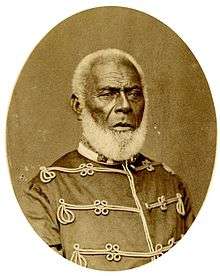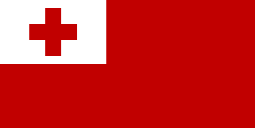History of Tonga
| Part of a series on the |
| Culture of Tonga |
|---|
| History |
| Languages |
| Religion |
| Literature |
|
Music and performing arts |
| Sport |
|
Symbols |
|
|
The history of Tonga is recorded since the century after 900 BC, when seafarers associated with the Lapita diaspora first settled the islands which now make up the Kingdom of Tonga.[1] Along with Fiji and Samoa, the area served as a gateway into the rest of the Pacific region known as Polynesia.[2] Ancient Tongan mythologies recorded by early European explorers report the islands of 'Ata and Tongatapu as the first islands having been hauled to the surface from the deep ocean by Maui.[3][4]
Pre-contact
The dates of the initial settlement of Tonga are still subject to debate; nonetheless, one of the oldest occupied sites is found in the village of Pea on Tongatapu. Radiocarbon dating of a shell found at the site reportedly dates the occupation at 3180 ± 100 BP (Before Present).[5] Some of the oldest sites pertaining to the first occupants of the Tongan Islands are found on Tongatapu which is also where the first Lapita ceramics were found by WC McKern in 1921.[6] Nonetheless, reaching the Tongan islands (without Western navigational tools and techniques) was a remarkable feat accomplished by the Lapita peoples. Not much is known about Tonga before European contact because of the lack of a writing system during prehistoric times other than the oral history told to the early European explorers. The first time the Tongan people encountered Europeans was in April 1616 when Jacob Le Maire and Willem Schouten made a short visit to the islands to trade.
Early culture
Centuries before Westerners arrived, Tongans created megalithic stoneworks. Most notably, these are the Haʻamonga ʻa Maui and the Langi terraced tombs. The Haʻamonga is 5 meters high and made of three coral-lime stones that weigh more than 40 tons each. The Langi are low, very flat, two or three tier pyramids that mark the graves of former kings.
Tongan Maritime Empire
By the 12th century, Tongans, and the Tongan kings named the Tu'i Tonga, were known across the Pacific, from Niuē, Samoa to Tikopia. They ruled these nations for more than 400 years, sparking some historians to refer to a "Tongan Empire", although it was more of a network of interacting navigators, chiefs, and adventurers. It is unclear whether chiefs of the other islands actually came to Tonga regularly to acknowledge their sovereign. Distinctive pottery and Tapa cloth designs also show that the Tongans have travelled from the far reaches of Micronesia, to Fiji and Hawaii.
European arrival and Christianization

In the 15th century and again in the 17th, civil war erupted. It was in this context that the first Europeans arrived, beginning with Dutch explorers Willem Schouten and Jacob Le Maire. Between April 21 to 23, 1616 they moored at the Northern Tongan islands "Cocos Island" (Tafahi) and "Traitors Island" (Niuatoputapu), respectively. The kings of both of these islands boarded the ships and Le Maire drew up a list of Niuatoputapu words, a language now extinct. On April 24, 1616, they tried to moor at the "Island of Good Hope" (Niuafo'ou), but a less welcoming reception there made them decide to sail on.
On January 21, 1643, the Dutch explorer Abel Tasman was the first European to visit the main island (Tongatapu) and Haʻapai after rounding Australia and New Zealand. He mapped several islands. The most significant impact had the visits of Captain Cook in 1773, 1774, and 1777, followed by the first London missionaries in 1797, and the Wesleyan Methodist Walter Lawry in 1822. Around that time, most Tongans converted en masse to the Wesleyan (Methodist) or Catholic faiths. Other denominations followed, including Pentecostals, Mormons, Seventh-day Adventists and most recently the Bahá'í faith.
The islands were also visited by the Spanish under Francisco Antonio Mourelle in 1781 and Alessandro Malaspina, (who unsuccessfully claimed Vavau for Spain) in 1793 and by the French under Marc-Joseph Marion du Fresne in 1772, Jean-François de Galaup, comte de Lapérouse in 1787 and Antoine Bruni d'Entrecasteaux in 1793.[7]
Unification

In 1799, the 14th Tuʻi Kanokupolu, Tukuʻaho was murdered, which sent Tonga into a civil war for fifty years. Finally, the islands were united into a Polynesian kingdom in 1845 by the ambitious young warrior, strategist, and orator Tāufaʻāhau. He held the chiefly title of Tu'i Kanokupolu, but was baptised with the name King George Tupou I. In 1875, with the help of missionary Shirley Baker, he declared Tonga a constitutional monarchy, at which time he emancipated the serfs, enshrined a code of law, land tenure, and freedom of the press, and limited the power of the chiefs. The islands were not fully surveyed until 1898, when the British warships HMS Egeria (1873) and HMS Penguin (1876) completed the task.[7]
Tonga became a British protected state under a Treaty of Friendship on May 18, 1900, when European settlers and rival Tongan chiefs tried to oust the second king. The Treaty of Friendship and protected state status ended in 1970 under arrangements established prior to her death by the third monarch, Queen Sālote. Tonga joined the Commonwealth of Nations in 1970, and the United Nations in 1999. While exposed to colonial forces, Tonga has never lost indigenous governance, a fact that makes Tonga unique in the Pacific and boosts confidence in the monarchical system. The British High Commission in Tonga closed in March 2006.
Tonga's current king, Tupou VI, traces his line directly back through six generations of monarchs. The previous king, George Tupou V, born in 1948, continued to have ultimate control of the government until July 2008. At that point, concerns over financial irregularities and calls for democracy led to his relinquishing most of his day-to-day powers over the government.[8]
See also
- History of Oceania
- List of monarchs of Tonga
- Prime Minister of Tonga
- Politics of Tonga
- Kingdom of Tonga (1900–70)
References
- ↑ D Burley et al. 2012 High Precision U/Th Dating of First Polynesian Settlement PLOS ONE November 07, 2012
- ↑ DV Burley. 1998. Tongan Archaeology and the Tongan Past, 2850-150 B.P. In: Journal of World Prehistory 12:337–392
- ↑ Honolulu: The Museum
- ↑ John Martin. 2005 (reprint). William Mariner: An Account of the Natives of the Tonga Islands in the South Pacific Ocean. Vol. 1. Elibron Classics
- ↑ Kirch 1997:273
- ↑ WC McKern. 1929. Archaeology of Tonga. Bernice P. Bishop Museum Bulletin 60
- 1 2 Quanchi, Historical Dictionary of the Discovery and Exploration of the Pacific Islands, page 239
- ↑ "Tonga's king to cede key powers", BBC, July 29, 2008
Further reading
- Queen Salote of Tonga: The Story of an Era 1900–1965 (ISBN 1-86940-205-7)
- Latukefu, S. (1974)Church and State in Tonga, ANU Press, Canberra
- Quanchi, Max (2005). Historical Dictionary of the Discovery and Exploration of the Pacific Islands. The Scarecrow Press. ISBN 0810853957.
External links
- Tonga Visitors Bureau, Ministry of Tourism, Kingdom of Tonga
- Photo of Haʻamonga Trilithon
- The Friendly Islands: 1616 to 1900
